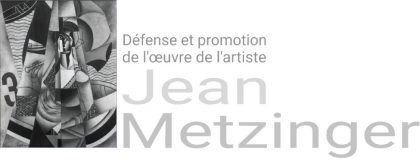Catalogue Raisonné Jean Metzinger

Número: AM-35-010 Jean Metzinger
Date: 1935-44 (circa)
Titre: Femme à la Mandoline
Technique: Huile sur toile
Dimensions: 92 x 73 cm
Inscriptions: Signed (lower left)
Provenance: M. Camille Renault, Paris.
Vincent F. Wapler, Hôtel Drouot, Paris, 1 April 1985, lot 189.
Ader Picard Tajan, Hôtel Drouot, Paris, th March 1986, lot 69.
Private Collection, Paris (acquired at the above sale).
Sotheby’s, New York, 8 May 2008, lot 378.
Anonymous (acquired at the above sale)
Sotheby’s, London, 6 February 2014, lot 553
Littérature: Joann Moser, Daniel Robbins, Jean Metzinger in Retrospect, The University of Iowa Museum of Art, 1985, catalogue, no. 184, p. 106, reproduced
Notes: Sotheby’s (6 February) lists the 1985 Metzinger in Retrospect reference under Exhibited, whereas it should have been cited under Literature, since it was reproduced in the catalogue but not exhibited. The 1985 catalogue mentions provenance as Galerie Daniel Malingue. There is no record of its presence in the Malingue archive.
Metzinger himself wrote in 1922, “I know works whose thoroughly classical appearance conveys the most personal [the most original] the newest conceptions…. Now that certain Cubists have pushed their constructions so far as to take in clearly objective appearances, it has been declared that Cubism is dead [in fact] it approaches realization.'” (Jean Metzinger, Tristesse d’Automne, Montparnasse, 1 December 1922, p. 2.) The same held true of Metzinger’s work extending into the 1930s and 1940s. This work was both constructive and concomitant with Cubism. This work, just as all of Metzinger’s production following the First World War, employs the ‘Cubist language to the look of nature’. (C. Greene, Cubism and its Enemies, Modern Movements and Reaction in French Art, 1916-1928, Yale University Press, New Haven and London, 1987)
The strict constructive ordering that had become so pronounced in Metzinger’s pre-1920 Cubist works is present in Jeune Femme à la Mandoline, in the careful positioning of form, color, and in the way in which Metzinger delicately assimilates the union of figure and background, of light and shadow. For example, the division of the model’s features generates a subtle profile view that results from a free and mobile perspective. (Snippet of Sotheby’s 8 May 2008, Catalogue Note, written by Alexander Mittelmann)

